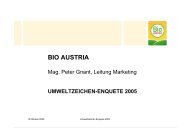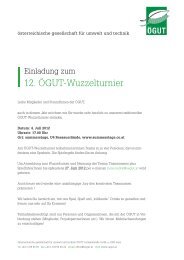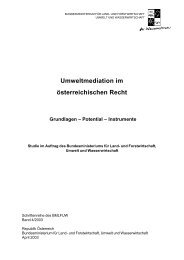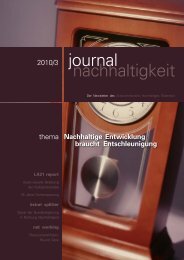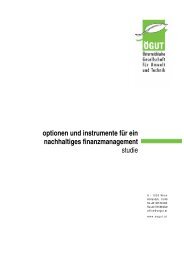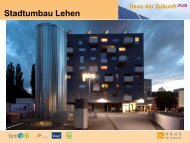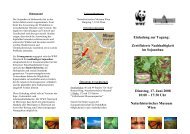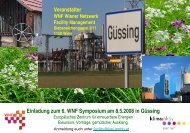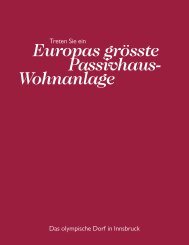Symposium „Environmental Mediation in Europe“ - ÖGUT
Symposium „Environmental Mediation in Europe“ - ÖGUT
Symposium „Environmental Mediation in Europe“ - ÖGUT
Erfolgreiche ePaper selbst erstellen
Machen Sie aus Ihren PDF Publikationen ein blätterbares Flipbook mit unserer einzigartigen Google optimierten e-Paper Software.
<strong>Symposium</strong> <strong>„Environmental</strong> <strong>Mediation</strong> <strong>in</strong> <strong>Europe“</strong>, 22/23.11.2001, Vienna<br />
"ROUND TABLE" STRATEGIC ENVIRONMENTAL ASSESSMENT -<br />
FINDING CONSENSUAL AND ENVIRONMENTALLY SOUND<br />
PLANNING SOLUTIONS<br />
Kerst<strong>in</strong> Arbter<br />
Abstract<br />
This paper discusses environmental mediation at the level of plans and programmes and its<br />
l<strong>in</strong>ks with Strategic Environmental Assessment (SEA). SEA is an <strong>in</strong>strument with the aim to<br />
<strong>in</strong>tegrate environmental aspects <strong>in</strong>to plans and programmes. Environmental mediation focuses<br />
on balanc<strong>in</strong>g different <strong>in</strong>terest groups. The comb<strong>in</strong>ation of both <strong>in</strong>struments is sensible<br />
and already proved <strong>in</strong> the Viennese plann<strong>in</strong>g practise. The model of l<strong>in</strong>kage is called "SEA at<br />
the round table". This means that <strong>in</strong>terest groups, which are concerned by the plan or programme<br />
take place <strong>in</strong> the SEA process. This can lead to plans and programmes, which are<br />
on the one side optimised for the environment and on the other side well supported by different<br />
<strong>in</strong>terest groups, because the <strong>in</strong>terests have been balanced dur<strong>in</strong>g the process. L<strong>in</strong>k<strong>in</strong>g<br />
both tools allows to use synergies, firstly to improve the way of public participation <strong>in</strong> SEA<br />
processes and secondly to improve the quality of the results of the SEA. Probably there exist<br />
even more sensible comb<strong>in</strong>ations of different plann<strong>in</strong>g and decision-mak<strong>in</strong>g <strong>in</strong>struments. By<br />
conduct<strong>in</strong>g pilot projects and by <strong>in</strong>ternational exchange of experiences we can get a step<br />
forward to develop the appropriate tool-mixture to come to consensual and environmentally<br />
beneficial plann<strong>in</strong>g solutions.<br />
Introduction<br />
So far environmental mediation is mostly used at the level of projects. The project level is a<br />
plann<strong>in</strong>g level near to the bottom of the plann<strong>in</strong>g hierarchy. To reach this quite precise project-level<br />
many decisions have been taken before <strong>in</strong> more general plans and programmes.<br />
They have been prepared before gett<strong>in</strong>g <strong>in</strong>to greater detail by develop<strong>in</strong>g special projects.<br />
These plans and programmes often <strong>in</strong>clude decisions which are relevant for the environment<br />
and which concern different <strong>in</strong>terest groups. Tak<strong>in</strong>g these facts <strong>in</strong>to account, the idea to use<br />
mediation elements also at the level of plans and programmes is grow<strong>in</strong>g to a topic of immediate<br />
<strong>in</strong>terest. In this connection it is worth to look for l<strong>in</strong>ks with <strong>in</strong>struments, that are already<br />
established at the level of plans and programmes, <strong>in</strong> order to use as many synergies as possible.<br />
One important tool at this higher plann<strong>in</strong>g level is Strategic Environmental Assessment,<br />
<strong>in</strong> short: SEA.<br />
This paper discusses how mediation at the level of plans and programmes is work<strong>in</strong>g and<br />
what k<strong>in</strong>d of synergies with the <strong>in</strong>strument of Strategic Environmental Assessment (SEA)<br />
exist. A model of <strong>in</strong>tegrat<strong>in</strong>g the two <strong>in</strong>struments, environmental mediation on the one side,<br />
and Strategic Environmental Assessment on the other side, is presented. This model is<br />
called "SEA at the round table". It contributes to consensual and environmentally beneficial<br />
plann<strong>in</strong>g solutions gett<strong>in</strong>g its force from the synergies of the comb<strong>in</strong>ation of both tools. To<br />
deal with this issue this paper focuses on three major areas: firstly, on the question: What is<br />
SEA; <strong>in</strong>clud<strong>in</strong>g SEA aims, elements, and its legal background, secondly, on the question:<br />
What do the two <strong>in</strong>struments have <strong>in</strong> common and what are the differences; and thirdly, and<br />
f<strong>in</strong>ally, on the central question: Where are the l<strong>in</strong>ks and synergies between environmental<br />
mediation and SEA. To round up the discussion at the end there are some conclusions and<br />
h<strong>in</strong>ts from the author's view for further and common development of both <strong>in</strong>struments. The<br />
ma<strong>in</strong> po<strong>in</strong>t towards l<strong>in</strong>ks and synergies is illustrated by the example of the "SEA for the Viennese<br />
Waste Management Plan", where the <strong>in</strong>tegrated model "SEA at the round table" was<br />
tested successfully <strong>in</strong> plann<strong>in</strong>g practise.<br />
84



